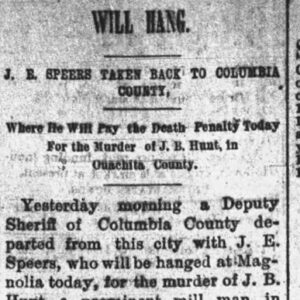calsfoundation@cals.org
J. E. Speers (Execution of)
J. E. Speers was hanged on May 27, 1892, in Magnolia (Columbia County) for the slaying of a Ouachita County timber man, a crime he claimed was committed in self-defense.
J. E. Speers was born in 1863 in St. Francis County. He married Annie Hutson, “a rustic beauty,” near Brinkley (Monroe County) twenty years later, and they would have five children, two of whom lived. Speers worked as a railroad engineer for some time, but by 1892 “for several years ha[d] been employed in various capacities about saw mills.” The Arkansas Gazette described him as “one of the Smith and Wesson gentry, and an all around tough.”
Speers was working at a mill near Camden (Ouachita County) as a night watchman for G. C. Hunt, “a prominent mill man in Ouachita County,” who fired him on June 30, 1893. Speers returned to the mill the next night to retrieve his lantern, and he and Hunt got into an argument, with Speers claiming that “Hunt attempted to draw a pistol when he (Speers) fired, killing him.” Speers “made no attempt to escape, and was arrested at the scene of the murder.”
Accused of murder despite his claim of self-defense, Speers received a change of venue to Columbia County. After a trial that lasted several days, and in which “most of the evidence was of a circumstantial nature,” the jury deliberated for less than ten minutes before finding Speers guilty of first-degree murder, the first time “a white man has been convicted here to hang for more than twenty years.” A judge sentenced him on February 27 to be executed on May 27, 1892, though Speers “still strongly denies his guilt, and insists his trial was an unfair one.” The condemned man was taken to the state penitentiary in Little Rock (Pulaski County) for safekeeping.
The judgement was appealed to the Supreme Court of Arkansas, which affirmed the sentence. Speers wrote Governor James P. Eagle on May 22 seeking a commutation because “I was fully impressed with the belief that Mr. Hunt…was about to take my life.” Eagle, assured that there was no doubt of Speers’s guilt, declined to commute the sentence.
On the morning of May 27, Speers spent time praying with his spiritual advisor. His wife and children were allowed into the Columbia County jail to see him, and when they left at 1:00 p.m. several men gave money to the “penniless” widow. Speers declared himself “at peace with his Maker and nothing but the future welfare of his family was a source of any trouble to him.”
“The crowd was immense,” and “passes into the enclosure surrounding the scaffold were largely sought” when Speers was brought out of the jail. He spoke to the crowd for several minutes, and a Gazette correspondent wrote that “he seemed cool and his remarks were sensible and connected.”
After entering the enclosure, Speers was “firm and deliberate” until stepping on the gallows’ trap door, “which seemed to open suddenly to him and to give him a perfect realization of his awful doom, which caused him to break into violent weeping.” The trap opened at 2:00 p.m., “and in eight minutes the body hung motionless.”
For additional information:
Arkansas Democrat, February 29, 1892, p. 1.
“Convicted of Murder.” St. Louis [Missouri] Globe-Democrat, February 20, 1892, p. 3.
“Goes to the Gallows.” Arkansas Gazette, February 28, 1892, p. 6.
“Hanged.” Arkansas Democrat, May 28, 1892, p. 1.
“He Will Hang.” Arkansas Gazette, February 20, 1892, p. 1.
“To the Gallows.” Arkansas Democrat, May 26, 1892, p. 1.
“With Tears.” Arkansas Gazette, May 28, 1892, p. 3.
Mark K. Christ
Central Arkansas Library System
 Law
Law Post-Reconstruction through the Gilded Age, 1875 through 1900
Post-Reconstruction through the Gilded Age, 1875 through 1900 J. E. Speers Execution Story
J. E. Speers Execution Story  J. E. Speers Execution Story
J. E. Speers Execution Story  J. E. Speers Execution Story
J. E. Speers Execution Story 




Comments
No comments on this entry yet.